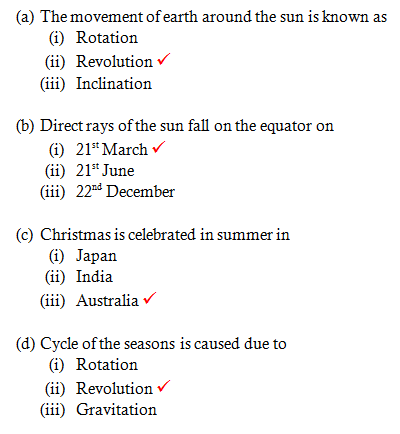Class 6 NCERT Solutions Geography Chapter 3: Motions of the Earth
Motions of the Earth Exercise 21
Solution 1
(a) The angle of inclination of the earth’s axis is 22 ½º. It forms an angle of 66 ½º with the orbital plane.
(b)Rotation: It is defined as the movement of Earth around its own axis. It takes Earth 24 hours to complete a rotation.
Revolution: It is defined as the movement of Earth around the sun in a fixed orbit. It takes Earth 365 ¼ days to complete a revolution
(c) Leap year is a year which has 366 days instead of usual 365 days. This is because earth takes 365 days and 6 hours to complete a revolution. But, for the sake of convenience, we consider that a year consists of 365 days. This leads to exclusion of 6 hours for three consecutive years. However, these 6 hours constitute a day in four year (6+6+6+6 = 24). Therefore, one day is added to that year in the month of February, which becomes the month of 29 days once in four years.
(d)
| Summer Solstice | Winter Solstice |
|
It is the time when the whole northern hemisphere experiences more heat and light. This is because the sun falls directly on the Tropic of Cancer. |
It is the time when the whole southern hemisphere experiences more heat and light. This is because the sun falls directly on the Tropic of Capricorn. |
|
At this time, the North pole is tilted towards the sun. |
At this time, the South pole is tilted towards the sun. |
|
Due to large portion being tilted, it is summer in Northern Hemisphere. |
Due to large portion being tilted, it is summer in Southern Hemisphere. |
|
Reverse conditions prevail in the Southern Hemisphere. |
Reverse conditions prevail in the Northern Hemisphere. |
|
It occurs on 21st June in Northern Hemisphere. |
It occurs on 22nd December in Southern Hemisphere. |
(e) Equinox is defined as the position wherein neither of the poles is tilted towards the sun. This results in rays of the sun falling directly over the equator. This results in earth experiencing equal days and equal nights. Also, exactly half of the earth is in light and the other half is in dark. This phenomenon occurs twice in a year, i.e. on 21st March and 23rd September.
(f) The Southern Hemisphere experiences Winter and Summer Solstice in different times than that of Northern Hemisphere because:
- On 21st June, when the Northern Hemisphere is tilted towards the sun the Southern Hemisphere of course will be away from it. This leads to North Hemisphere experiencing summer solstice while Southern Hemisphere experiences winter solstice at the same time.
- On 22nd December, when the Southern Hemisphere is tilted towards the sun the Northern Hemisphere will be away from it. Therefore, this results in Southern Hemisphere experiencing summer solstice while Northern Hemisphere experiences winter solstice.
(g) The poles experience about six months day and six months of night because when the Northern Hemisphere tilts towards the sun, the North Pole is inclined towards the sun. This results in it experiencing light for the whole day. While North Pole is in light the South Pole does not get light during this time. This phenomenon takes place for a period of six months.
The conditions are reversed with respect to the Southern Hemisphere.
Solution 2
Solution 3
(a) A leap year has 366 number of days.
(b) The daily motion of the earth is rotational.
(c) The earth travels around the sun in an elliptical orbit.
(d) The sun's rays fall vertically on the Tropic of Cancer on 21st June.
(e) Days are shorter during winter season.

